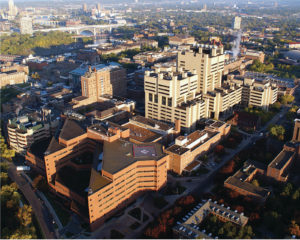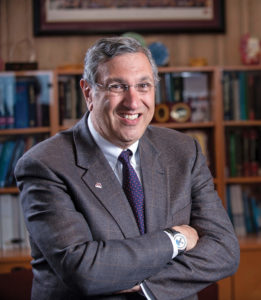BY Melanie Bavaria
The University of Minnesota is leading the way in training a whole new breed of dental specialists. Should dentists themselves be worried?
IT HAS BEEN 100 years since dental hygiene became a licensed profession, with formal technical training, in the United States. Hygienists have grown in importance ever since — a ubiquitous reminder, in practices throughout the land, that new specialties can exert a profound impact on a medical profession. Today, the University of Minnesota stands at the forefront of what may become a major specialty in the years ahead: dental therapy.
Common in many countries, dental therapists are mid-level providers who are trained to do more than hygienists but less than dentists; physician assistants and nurse practitioners are roughly analogous positions. Most importantly, dental therapists are intended to serve communities in which quality care is difficult if not impossible to access, particularly rural areas and low-income urban neighborhoods.

HEALTH HAPPENS HERE: Moos Tower (background) on UMN’s East Bank campus in Minneapolis. UMN Dental occupies nine oors of the facility.
In the wake of a 2009 law passed by the Minnesota legislature authorizing the licensing of dental therapists and advanced dental therapists — it was the first state legislature to do so — the University of Minnesota School of Dentistry in Minneapolis became the first dental school to establish a formal educational track for the discipline; its first class of dental therapists graduated in 2011. State law requires them to work among underserved communities and, like hygienists, under the direct or indirect supervision of a dentist.
In 2000, U.S. Surgeon General David Satcher released a report, Oral Health in America, which found that Americans had low oral-health awareness and that there existed “a significant disparity between racial and socioeconomic groups in regard to oral health and ensuing overall health issues.” Satcher called for practitioners to more closely link oral health to that of the whole body; he also announced his determination to prioritize the provision of dental care to those who lacked it. Unfortunately, there just didn’t seem to be enough dentists to go around.
Such was the situation both the state of Minnesota and UMN School of Dentistry were facing nine years later when they decided to turn to dental therapy as a possible solution. According to the Minnesota Department of Health, in 2010 just 26 percent of Gopher State dentists practiced in rural areas, and nearly half of the state’s clinicians were 55 or older.
“Dentists were not, on their own, able to serve all the population,” says Dr. Leon Assael, dean of UMN School of Dentistry. “We needed a better workforce to deal with this problem.”
More than 70 percent of Minnesota counties are considered to be “Health Profession Shortage Areas” (HPSAs) when it comes to dental care. Yet as Dr. Assael notes, having a dentist conduct checkups, fill cavities and extract teeth is just not cost-efficient for these patient populations. Most Minnesota dentists rarely, if ever, treat patients who have health care through Medical Assistance, the state’s Medicaid program.

HE’S THE BOSS: Dr. Leon Assael, UMN Dental’s dean since 2012
Dr. Assael, an oral and maxillofacial surgeon who has been dean of UMN Dental since 2012, has witnessed firsthand what can happen when people neglect their oral health: Among myriad other problems, emergency-room visits spike, burdening the system with substantially higher costs that could have been avoided or, at the very least, greatly reduced with preventive care.
Since Dr. Assael came aboard four years ago, UMN’s dental-therapy program has begun making inroads on the problem. In February 2014, the Minnesota Department of Health, in conjunction with the state’s Board of Dentistry, produced a report for the legislature, Early Impacts of Dental Therapists in Minnesota. At the time, the workforce statewide consisted of 32 licensed dental therapists, six of whom were advanced therapists who require less supervision. All of them were UMN graduates. They had served more than 6,000 new patients, 84 percent of whom were enrolled in Medical Assistance. The therapist rolls are still small enough, Dr. Assael says, that UMN has been able to keep tabs on what each graduate is doing and where they’re practicing. Almost all of them, he notes with pride, are working in Health Profession Shortage Areas.
Other states are considering following Minnesota’s lead. Maine has already authorized the licensing of dental therapists, and more than a dozen other states are debating doing so. But this Promethean creation of an entirely new class of dental professionals is controversial: Some dentists, as well as the American Dental Association, have pushed back, citing concerns that dental therapists overall will deliver lower-quality care, particularly when it comes to surgical procedures. They also argue that dentists have no financial incentive to hire therapists, who might eventually threaten dentists’ very jobs as well.
Dr. Assael isn’t buying it. The ADA’s implication that “the supply of dentists is adequate to serve America’s needs,” he says, is patently false and all but assures that greater numbers of at-risk individuals will go without access to dental care. He cites medical history to back up his assertions: Strong opposition greeted the creation of nurse practitioners and physician assistants (in the mid- and late 1960s), but both are now recognized as enabling doctors to concentrate on more specialized, complicated care, relegating their patients’ more basic needs to NPs and PAs. Dentists resisted as well, also in the 1960s, when hygienists were first permitted to do deep scaling, a task they now perform routinely and without controversy. “Change is hard for folks to accept,”
Dr. Assael says.
He analogizes the situation to the market for automobiles. “The number one barrier is cost,” he says. “The way you reduce costs is not by selling more high-end Maseratis, but by selling Fords. You’ve got to figure out how to sell the Ford.”
Established in 1851, the University of Minnesota was one of the country’s original land-grant colleges, and Dr. Assael sees his dental school as guided by those institutions’ precepts: to improve the lives of the people of Minnesota, the country and the world through knowledge, research and technology. For him, building UMN’s dental-therapy program is just one more good way to fulfill that mission



